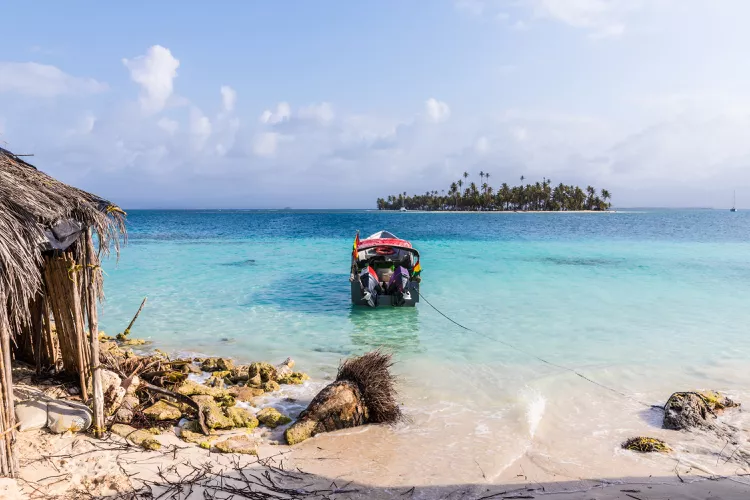Explore the Beautiful Islands of Panama
There are hundreds of Panama islands, from the massive Coiba Island to the perfectly tiny Kuna islets. Some are extremely tourist-friendly, like Isla Colón in the Bocas del Toro. Other Panama islands are remote and uninhabited but still packed with biodiversity. Explore the islands of Panama!
Guna Yala/Kuna Yala/San Blas Islands

The Guna Yala archipelago, formerly known as the Kuna Yala or San Blas archipelago, includes some of the most pristine islands in Central America. There are a total of 378 islands and islets, though only 49 are inhabited. Almost all of the archipelago’s residents are Kuna Indians, living in Kuna villages spanning entire islands. Accommodations for travelers are extremely basic throughout Kuna Yala, typically in huts on private isles, with meals consisting of whatever the fishermen bring in. But if you’re seeking the definition of idyllic, these Panama islands are it.
Coiba Island

Coiba Island is the largest island not only in Panama but in all of Central America. Located off Panama’s Pacific Coast in the Gulf of Chiriquí, the island was once part of continental Panama but split when sea levels rose 12,000 to 18,000 years ago. Consequently, a number of endemic subspecies are found on the island, like the Coiba Agouti, the Coiba Spinetail, and the Coiba Howler Monkey. Three-fourths of the island is covered in forest, much of it ancient. A penal colony, infamous for its reputation, housed prisoners on the island from 1919 until it was closed in 2004. Currently, the island is a UNESCO World Heritage Site, popular with eco-tourists and travelers seeking natural beauty off the beaten path.
Bocas del Toro Islands

The Bocas del Toro Islands are Panama’s most popular travel destination. Located in the Caribbean Sea, close to the Costa Rican border, they can be reached by ferry, water taxi, or plane. The largest of the Bocas del Toro islands is Isla Colón, home to Bocas Town (also called Bocas del Toro). Approximately 13,000 people live in Bocas Town, which offers numerous hotels, restaurants, and other tourist attractions. Neighboring Bastimentos Island is another great destination, particularly Red Frog Beach, named for the tiny red poison dart frogs dwelling there. Additionally, other Bocas del Toro islands are less traveled, but equally stunning—such as Solarte Island, settled by the indigenous Ngöbe-Buglè people, and the Zapatillas Cays, part of Isla Bastimentos National Park.
The Gulf of Chiriquí

Along with Coiba Island, dozens of Panama islands are located in southwest Panama’s Gulf of Chiriquí. Most travelers exploring the region start in the town of Boca Chica, where transportation can be arranged to the gulf’s islands. For instance, the island of Boca Brava is just half a mile away. Isla Palenque, located near Boca Brava, is another great destination for hiking and sport fishing. The Islas Secas, also known as “dry islands,” is an archipelago consisting of sixteen pristine volcanic islands, and is home to the Islas Secas Resort.
The Pearl Islands

The Pearl Islands archipelago consists of approximately 100 islands, many of them tiny and uninhabited. They’re situated in the Gulf of Panama, around 30 miles from the coast. The islands have a wild, castaway feel—in fact, the CBS television show “Survivor” filmed three seasons on islands within the archipelago: Survivor: Pearl Islands, Survivor: All-Stars, and Survivor: Panama. The largest and most accessible of the Pearl Islands is Contadora Island, featuring a small airport (with a flight time from Panama City of just fifteen minutes). In Spanish, “Contadora” means “counter,” appropriately named since the island is where Spanish conquistadors counted the pearls harvested from other Pearl Islands. Furthermore, at 74,000 acres, Isla del Rey is the largest of the Pearl Islands and the second-largest island in Panama (after Coiba Island).
Isla Barro Colorado

Isla Barro Colorado is an island situated in Panama’s man-made Gatun Lake, in the middle of the Panama Canal. When the Chagres River was dammed to create the lake, all the rainforest was flooded except for the hills, which now comprise the island. This island houses the Smithsonian Tropical Research Institute, where scientists conduct research on the island’s flora and fauna. According to the institute, Barro Colorado “is one of the most studied places on Earth and has become a prototype for measuring the diversity of plant and animal life around the world.”





